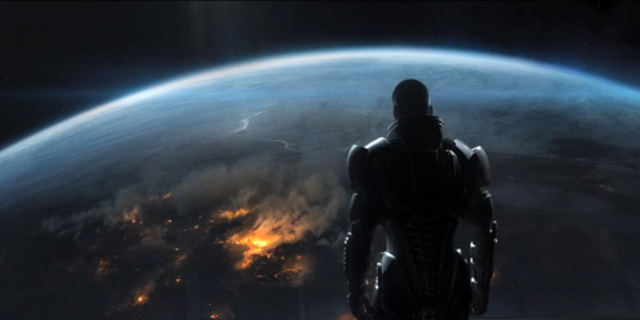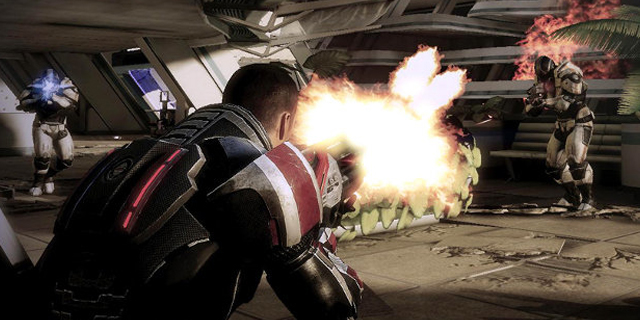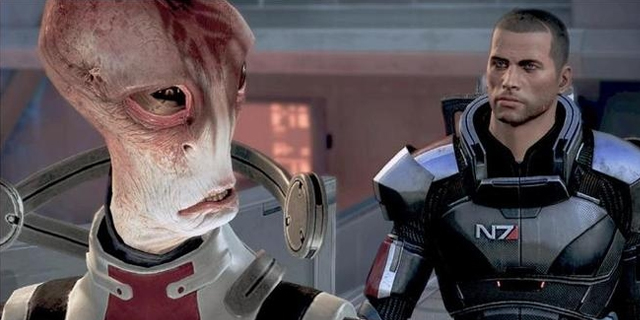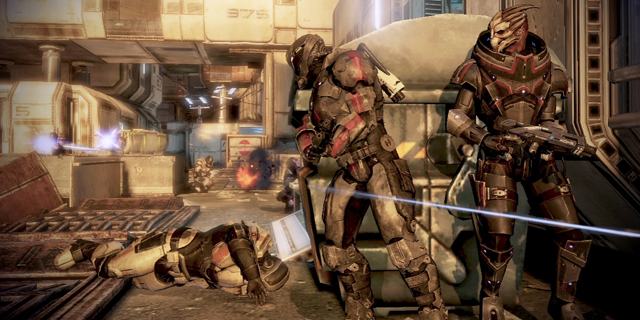
After months of anticipation, the third game in the Mass Effect trilogy is finally here. BioWare has successfully crafted this original universe in two widely-popular games, so there is a lot riding on Mass Effect 3 to deliver a satisfying conclusion to the science fiction trilogy. Due to the nature of the Mass Effect story and because of how much your choices matter, expectations are high. The end result is an experience unlike any other: a game that doesn’t always succeed, but manages to exceed those expectations when it matters most.
Starting off with a bang, Mass Effect 3’s plot centers on the universe-wide terror being spread by the Reapers, an ancient enemy force that has made its return. Shepard is on Earth when a Reaper force attacks the planet, forcing him/her back into action once again. The story mostly focuses on Shepard’s attempts to help every species in order to gain their support for the war against the Reapers. Shepard also deals with the Cerberus organization once again, this time as a major opponent in the war. The details of their involvement remain mysterious for a large part of the game, but it all comes together seamlessly in the end.
You regain control of the Normandy and find yourself encountering many of your allies from the previous Mass Effect games along the way, as well as a few new faces. The new characters, such as James Vega, fit in perfectly with the old cast; just like with Mass Effect 2, you’ll find yourself spending quite a lot of time getting to know them. Sometimes while wandering around the ship, you’ll come across two of your pals having a natural conversation. The writing is top-notch and leads to many of the best character moments in the entire series.

The story beats are often exciting, providing you with some of the toughest choices you will ever have to make. Many times throughout, I felt the need to put down the controller and really think about what to do next, something that even the last two Mass Effect games never inspired me to do. This leads to many intense or heartbreaking moments, all of which are executed flawlessly. Combine those with a score that never fails to hit at the right opportunities and you have a story that remains engrossing throughout.
I don’t really feel like many of the choices in Mass Effect 2 mattered very much. Sure, I made it through the suicide mission with 12 squaddies alive, and that I chose to destroy the Collector base factored into the story. What didn’t seem to matter was that everybody lived. Aside from a couple hand-picked by BioWare, making it through Mass Effect 2 simply meant a short cameo in Mass Effect 3. Either give me a good in-game reason why my favorite character can’t play, or let them in my squad. The whole thing manages to feel rushed and heavy-handed, and that’s odd in a BioWare game. – Justin Last
On top of that, you will find that the outcome of events in the previous games do impact the story in some major ways. For example, a certain dialogue option might be completely gone for those who made specific decisions in Mass Effect 2, which could change the way some events play out. While it’s not always perfect, the way BioWare has weaved together these three stories and your choices is an amazing achievement.
And unlike in previous games, the dialogue choices you make feel more natural now. You still gain paragon or renegade points depending on your decisions and actions, but you also gain reputation. This allows you to open up more of the significant dialogue without having to worry about making the “right” choices for your paragon or renegade character. I often found myself making choices that went against what I usually decide on, but still earned reputation because of it, allowing more dialogue options to be open in the future regardless of what I actually decided on. It’s a small change, but one that makes your decisions feel less one-sided and more intuitive.
As with the story itself, a large part of Mass Effect 3 revolves around you building up an effective military to fight against the Reapers. As you complete side quests, explore galaxies, and make certain decisions during critical story moments, you will increase your military strength. The more side content you do, the more this number will grow, and the better your chances of leading you to the best ending. The majority of the experience is based on this, including the multiplayer (which will be touched on shortly).

Just like in the previous Mass Effect games, you will be able to access the galaxy map from the Normandy and travel to any available galaxy. You will only be able to land on and explore specific planets, but thanks to the improved scanning, you have more reasons to explore galaxies you never have a reason to go to. Instead of scanning for minerals, each planet that can be scanned has something specific on it, either directly related to increasing your military strength or finishing a side quest that will inevitably do the same. It all feels more focused and less tedious than it did in Mass Effect 2, and I always found myself compelled to keep at it.
Mixed Kinect impressions
Mass Effect 3’s Kinect functionality is, for the most part, complimentary. The only area it fails in is its ability to detect what you are saying when trying to interact with an object or door. During battles, though, the squad commands are very useful. I’ve found myself commanding squadmates for the first time in the entire series, aside from required sections during the first two games. My only gripe: there’s no verbal feedback from your squad that they acknowledge you and are following your orders. – Shawn Vermette
Better with Kinect? I’m not sure this means what Microsoft thinks it means. Netflix and the 360 dashboard are better with Kinect. Why? Because after I start watching I can let the controller fall asleep and I’m still able to start the next episode and then eventually shut down Netflix and my 360 when I’m done using only my voice. Mass Effect 3, on the other hand, shoehorns in the peripheral where it isn’t needed. Make sure that you don’t mumble to yourself while making a decision and that your spouse doesn’t yell for you at the just the wrong time. I lost 30 minutes of play time to the Kinect interpreting “Justin, make sure you get the dog’s vaccination records out of the office” as “It’s over with her, I want us to be together.” – Justin Last
All of the small side quests are picked up on the Citadel. You pick these up from random citizens’ conversations about things they need during the war, which you will often find while scanning or during missions. If you aren’t thorough, it can be easy to miss a lot of side quests at the Citadel, but most of them you might just pick up without realizing it. Thankfully, you will get many opportunities to explore the Citadel, so the chances of you permanently missing quests are slim. These quests are simple enough that they never interfere with the flow of the rest of the game, for the most part.
That does lead to the major problem with Mass Effect 3: the pacing can be poor at times. After hearing about the Reaper threat and seeing how easily they take over Earth in the first hour of the game, there is a lack of urgency. This does improve once you reach the second half of the game, and the story quests and major side quests you go on are very important, but you just feel you can take all of the time in the world to do them. Giving the player the freedom to tackle the game at their own pace seemed to be the priority, so it’s understandable, it just could have been handled better.
The biggest improvements are found in the combat mechanics. This plays as well as the best third-person shooters on the market. The controls are tight and precise, the environments you find yourself in feel more open, and the enemies remain varied enough where you find yourself changing up your strategies often to keep things interesting. Squad commands work as well as ever, and if used correctly, you’ll never find yourself overrun or needing to worry about reviving your teammates as they manage to hold their own very well. The improvements to the combat allow Mass Effect 3 to feel like a more balanced experience as they manage to make the action sections stand alongside the story sections on equal footing.
New to the series is a cooperative multiplayer mode that has you and three other players complete wave-based battles against three different enemy types (Reapers, Geth, and Cerberus) on six different maps. The objective between each wave changes, sometimes forcing you to simply survive while other times making you capture control points or defeat specific targets in a certain amount of time. While the multiplayer isn’t groundbreaking, it works to the advantages of Mass Effect 3’s combat both in terms of the improved shooting mechanics and the variety in the races and classes you can choose from. Surprisingly enough, the multiplayer manages to stand out on its own as an enjoyable co-op experience that fits in perfectly with Mass Effect 3’s fiction.

New to the combat is the addition of weapon weight, which affects how often your biotics recharge. Your powers will either recharge faster or slower depending entirely on how many weapons you carry and how much each weapon weighs. It’s a nice touch as it allows the biotic-heavy classes to focus on carrying a single weapon and recharging their powers much faster as a result. This works best in multiplayer as it relies heavily on having a balanced team, so engineers can carry a pistol and nothing more while soldiers can carry some of the bigger guns without worrying about their small selection of biotics.
In single player, the tutorials push the weapon and power wheels as a great way to control your character and your companions. In multiplayer, the wheel is gone, because they couldn’t divorce the interface from freezing the action which just doesn’t work with four real, live, breathing people. A splash screen reminding me that I can change weapons by holding X, and that powers can be mapped to Y, LB, and RB, would have been great. As it is, I play just fine now, but I was certainly not a help to the first multiplayer squad I landed on. – Justin Last
As you play multiplayer, you will increase something called the “galactic readiness” percentage, which feeds directly into the single-player. At default, the percentage remains at fifty, meaning that half of your “current military strength” will actually be transferred into “effective military strength.” As the percentage increases, your EMS will increase. The EMS is what matters, as the higher it is, the higher your chances of achieving the best ending of the game is. It’s not necessary to play the multiplayer in order to achieve this, but it does allow players to make the process go faster and skip side quests if they so desire. This is a cool way to make your multiplayer progress tie in directly with your campaign progress. It rewards those players who wish to experience all Mass Effect 3 has to offer.
While it may not appease everyone, Mass Effect 3 offers a satisfying and engaging conclusion to the best gaming trilogy around. This is all thanks to some amazing story moments, great writing, and improved combat. This is a fitting end to Shepard’s story and hopefully not the last we will see of the dense Mass Effect universe.
Pros: Fantastic story moments, more enjoyable and improved combat, fun multiplayer
Cons: Some pacing issues



















